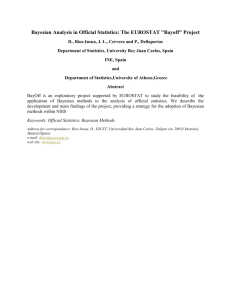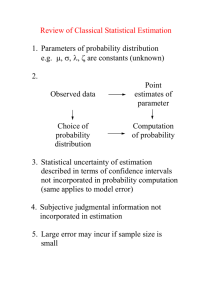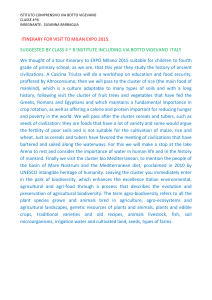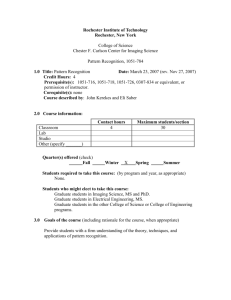ISBA 2000 : Tuesday Session 3
advertisement
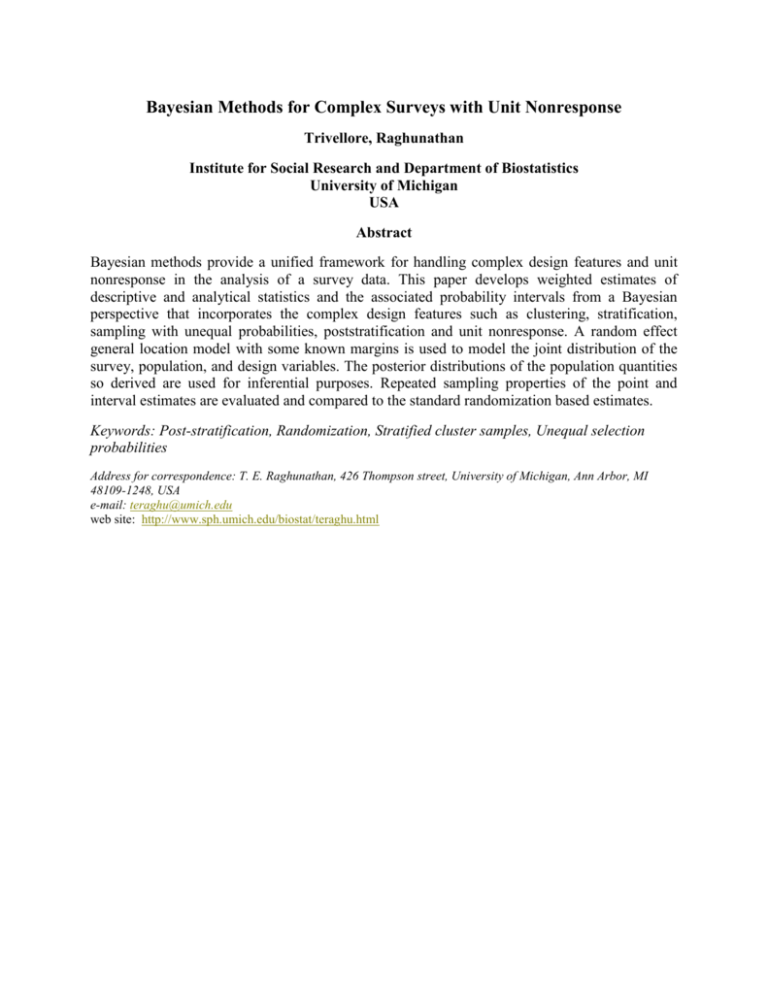
Bayesian Methods for Complex Surveys with Unit Nonresponse Trivellore, Raghunathan Institute for Social Research and Department of Biostatistics University of Michigan USA Abstract Bayesian methods provide a unified framework for handling complex design features and unit nonresponse in the analysis of a survey data. This paper develops weighted estimates of descriptive and analytical statistics and the associated probability intervals from a Bayesian perspective that incorporates the complex design features such as clustering, stratification, sampling with unequal probabilities, poststratification and unit nonresponse. A random effect general location model with some known margins is used to model the joint distribution of the survey, population, and design variables. The posterior distributions of the population quantities so derived are used for inferential purposes. Repeated sampling properties of the point and interval estimates are evaluated and compared to the standard randomization based estimates. Keywords: Post-stratification, Randomization, Stratified cluster samples, Unequal selection probabilities Address for correspondence: T. E. Raghunathan, 426 Thompson street, University of Michigan, Ann Arbor, MI 48109-1248, USA e-mail: teraghu@umich.edu web site: http://www.sph.umich.edu/biostat/teraghu.html Election forecasting: A Mexican experience Raúl Rueda Department of Probability and Statistics National University of Mexico Mexico Abstract In the Mexican Federal Elections, that have place every three years, it is desirable to have preliminary results a few hours after the electoral pools close. Since many electoral pools are too difficult to access, a clasification process, based in the Kullback-Lieble divergence, is used to choose a sample that will be use, in a conjugate analysis, to make the electoral forecasting. Some results of the 1994 election will be presented. Keywords: Kulback-Liebler divergence, forecasting, conjugate analysis Address for correspondence: Raúl Rueda, Apdo. Postal 20-276, 01000 Mexico D.F. e-mail: pinky@sigma.iimas.unam.mx Empirical and hierarchical Bayes small area estimation for the Italian Labour Force Survey Claudia, De Vitiis, Piero D., Falorsi, Stefano, Falorsi, Daniela Pagliuca and Aldo, Russo Istituto Nazionale di Statistica Italy and Roma Tre University Italy Abstract The topic of small area estimation has received much attention in the recent statistics literature. Small area estimation is concerned with using sample data from a population, scattered over a large domain, to make inferences about the average, or total, of some quantity in sub domains of that population. The problem of small area estimation can, in many instances, be formulated as a special case of the general problem of predicting the realization of a random variable w based on the value of an observable random vector y , when y follows a mixed linear model with a single set of random effects and w is a linear combination of fixed and random effects. A primary purpose of the present paper is to review and discuss some recent results on the general predition problem and the special case of small area estimation. Our coverage includes both frequentist and bayesian approches. In particular, we discuss the relationships between the approches, examine the computations required to implement the various approches. The frequentist properties of the bayesian and non-bayesian procedures are evaluated using sample data of Italian Labour Force Survey. Keywords: Small area estimators, Mixed linear models , Bayesian approches Address for correspondence: Stefano Falorsi, via A. Depretis, 74/B 00185 Roma Italy e-mail: stfalors@istat.it Reversible jump MCMC analysis of spatial Poisson cluster processes John Castelloe Linear Models R&D SAS Institute Inc. USA Abstract A reversible jump Markov chain Monte Carlo (RJMCMC) technique for bivariate normal mixtures with common covariance matrix is developed and applied to a special type of spatial point process, namely the Poisson cluster process with bivariate normal offspring dispersal. Inference for this type of process focuses on the common covariance matrix of the offspring dispersal distribution. RJMCMC extends the traditional MCMC capabilities by providing for transitions between different parameter spaces, which are needed in our situation due to the unknown number of clusters. A new convergence assessment method, applicable to any RJMCMC situation in which distinct models can be identified, is designed and theoretically justified. A "model" in our case is a given number of clusters, in other words, the number of components in a mixture. Output analysis methods are also developed, including anisotropy testing/estimation and inference for number of clusters. The RJMCMC technique is flexible and has potential to apply to more complicated spatial point processes, and also other mixture-related problems. A second newly developed method, discussed briefly for comparison, combines EM algorithm parameter estimates, computed separately for different numbers of clusters, in a Bayesian model averaging type scheme. A "composite EM" estimator of the covariance matrix is thus constructed, along with an estimated asymptotic variance computed from a combination of observed information matrices. Keywords: bivariate normal mixture, convergence assessment, reversible jump MCMC, Poisson cluster process, mixture models, EM algorithm Address for correspondence: John Castelloe, SAS Institute Inc., SAS Campus Dr., Cary, NC, 27513, USA e-mail: john.castelloe@sas.com web site: http://www.stat.uiowa.edu/~jcaste Bayesian Partitioning for Estimating Disease Risk David Denison and Chris Holmes Department of Mathematics Imperial College of Science, Technology and Medicine U.K. Abstract This talk presents a Bayesian nonparametric approach for the analysis of spatial count data. It extends the Bayesian partition methodology of Holmes, Denison and Mallick (1999) to handle data, which involves counts. A demonstration involving incidence rates of leukemia in New York state is used to highlight the methodology. The model allows us to make probability statements on the incidence rates around point sources without making any parametric assumptions about the nature of the influence between the sources and the surrounding location Keywords: Bayesian computation; Leukemia incidence data; Markov chain Monte Carlo (MCMC); Point source; Spatial count data; Voronoi tessellation Address for correspondence: Dr D. Denison, Dept. of Mathematics, Imperial College, 180 Queen's Gate, London, SW7 2BZ e-mail: d.denison@ic.ac.uk web site: http://www.ma.ic.ac.uk/~dgtd/ Bayesian Modelling of a General Class of Random Object Cluster Forms Andrew B. Lawson Department of Mathematical Sciences University of Aberdeen UK Abstract The analysis of spatial data where the location of events is known provides a rich area for Bayesian modeling. When spatial coordinates are known then spatial models focussed on the point pattern of events can be employed. In what follows we examine the possibility of modeling the clustering behavior of events in relation to a variety of possible cluster center types, via the use of cluster distribution functions relating locations to putative cluster centers. Our task is to estimate or reconstruct the center locations from data where centers are unobserved. Here centers are taken to be either a point process or a line process exhibited at (possibly) different spatial scales. In previous work in the area of cluster detection via parametric modelling, it has been assumed that relatively regular clusters form around putative cluster center locations. Often these locations have isotropic radial cluster densities around them, relating the event locations to the centers. This leads to circular forms of clustering. These forms may be unrealistic when applied as a uniform model across a study window. An extension to the point-process cluster center model is examined which allows two types of cluster to be modeled. As clusters often have relatively irregular shapes, it is useful to consider how it is possible to specify a parametric cluster form, which can capture such irregularity. The form, which we examine here, is the line segment. This form can be defined uniquely in space and can allow a more flexible cluster structure. We also note that given the computational framework we adopt (i.e. RJMCMC), a variety of line segment types can be sampled within any algorithm run, and hence different lengths and orientations of segments will be sampled. In what follows we adopt a simple mechanism for the proposal of line segments which involves a reversible transition from point locations and line segments (i.e we join point centers to produce line segments and vice-versa), thereby introducing a partition of the point center configuration into two classes: points and lines. Keywords: cluster line P-center L-center spatial RJMCMC Address for correspondence: Dr Andrew B. Lawson, Dept of Mathematical Sciences, University of Aberdeen, Aberdeen, UK AB24 3UE e-mail: a.lawson@maths.abdn.ac.uk web site: www.maths.abdn.ac.uk/maths/department/staff/pages/lawson_a.html Particle methods for filtering and smoothing in time-varying autoregressions Simon Godsill and Arnaud Doucet and Mike West Department of Engineering, University of Cambridge, UK and Department of Engineering, University of Cambridge,UK and ISDS, Duke University,USA Abstract We develop methods for performing smoothing in non-linear non-Gaussian dynamical models. The methods rely on a particle cloud representation of the filtering distribution, which evolves through time using importance sampling and resampling ideas. In particular, novel techniques are presented for generation of random realizations from the joint smoothing distribution and for MAP estimation of the state sequence. Realizations of the smoothing distribution are generated in a forward-backward procedure, while the MAP estimation procedure can be performed in a single forwards or backwards pass of the Viterbi algorithm applied to the discretised version of the state space. An application to spectral estimation for time-varying autoregressions is described. Keywords: particle filter, simulation smoothing, Viterbi, MAP estimation Address for correspondence: Simon Godsill, Signal Processing Group, University of Cambridge, Cambridge CB2 1PZ, UK e-mail: sjg@eng.cam.ac.uk web site: www-sigproc.eng.cam.ac.uk/~sjg Asymptotic Results for Interacting Particle Methods with Application to NonLinear Estimation Pierre, Del Moral Laboratoire de Statistique et Probabilités Université Paul Sabatier (Toulouse III) France Abstract A path-valued interacting particle systems model for the genealogical structure of a genetic algorithm is presented. We connect this historical process with a class of Feynman-Kac formulas. We also show how these genealogical particle models can be used to solve numerically non-linear smoothing and filtering problems. Keywords: Address for correspondence: Pierre Del Moral Laboratoire de Statistique et Probabilités 118 route de Narbonne 31062 TOULOUSE Cedex France e-mail: delmoral@cict.fr web site: http://www-sv.cict.fr/lsp/Delmoral/ Particle Filters for Demodulation of M-ary Modulated Signals in Noisy Fading Communication Channels E., Punskaya, C., Andrieu, A., Doucet and W.J., Fitzgerald Signal Processing Laboratory, Department of Engineering University of Cambridge UK Abstract The problem of recovering a message coded as a sequence of symbols and passed through a transmission channel is of great interest in statistical signal processing and communications. The channel will generally corrupt the original symbol sequence (due to amplitude gain, phase shifts, interferences and thermal noise) and the aim of this paper is to recursively compute the sequence. Recovering the original sequence from the observations is a challenging non-linear filtering problem, and several classical schemes have, in the past, been proposed to solve it, including the extended Kalman filter (EKF) and the Gaussian sum filter. These sub-optimal approaches are known to fail in realistic difficult situations. In this paper, we develop an efficient simulationbased algorithm, based on particle filters, to obtain the estimates of the posterior distribution of the symbols from the observations. The method combines sequential importance sampling, a selection scheme, Markov chain Monte Carlo methods and variance reduction techniques. An application to the problem of demodulation of digital M-ary differential phase shift keyed (MDPSK) signals are presented and an extensive simulation study is carried out. The results show that the algorithm outperforms the current methods that are routinely used in most communication applications. Keywords: Address for correspondence: W.J. Fitzgerald, Signal Processing Laboratory, Department of Engineering, University of Cambridge, Trumpington St., CB2 1 PZ, Cambridge, UK e-mail: wjf@eng.cam.ac.uk web site: www-com-serv.eng.cam.ac.uk/people/wjf.html

